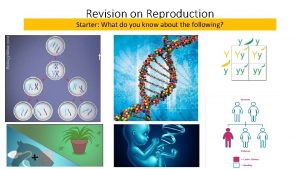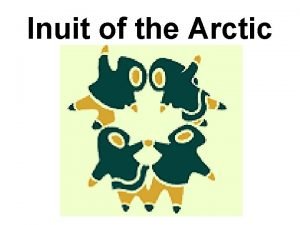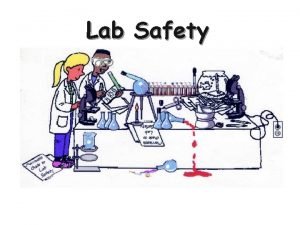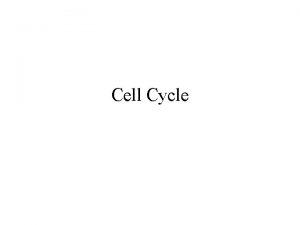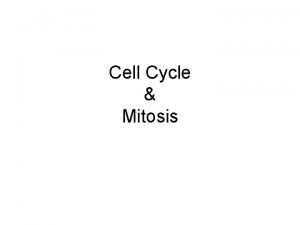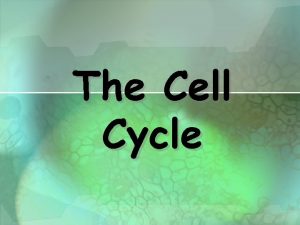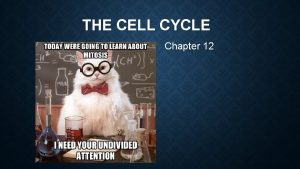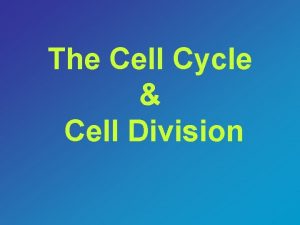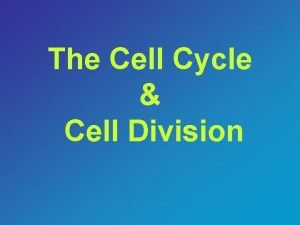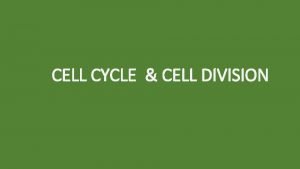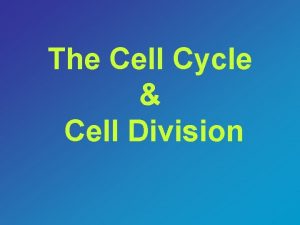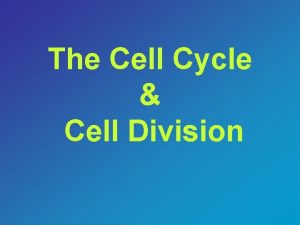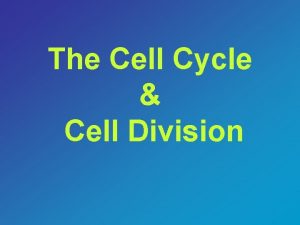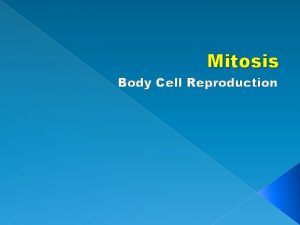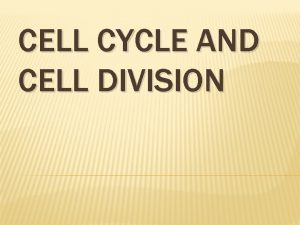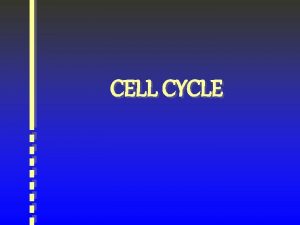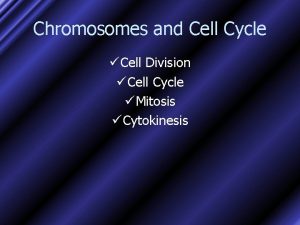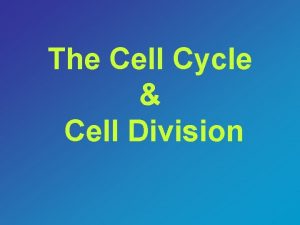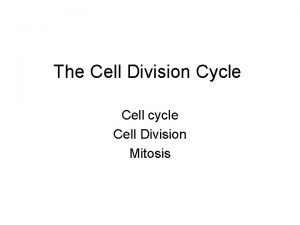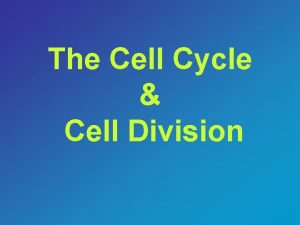THE CELL CYCLE Chapter 12 YOU MUST KNOW





















- Slides: 21

THE CELL CYCLE Chapter 12

YOU MUST KNOW • The structure of a duplicated chromosome. • The events that occur in the cell cycle (G 1, S, G 2). • The role of cyclins and cyclin-dependent kinases in the regulation of the cell cycle. • Ways in which normal cell cycle is disrupted to cause cancer, or halted in certain specialized cells, • The features of mitosis that result in the production of genetically identical daughter cells including replication, alignment of chromosomes (metaphase), and separation of chromosomes (anaphase).

Cell Cycle – life of a cell from when it is first formed from a dividing parent cell until its own division into two cells

• Somatic cells – all “body” cells except for gametes (eggs and sperm) • Called diploid – contain two full sets of chromosomes (one from each parent) • Gametes are haploid – contain only one set of chromosomes so that when they combine, the zygote formed will contain 2 complete sets again

• The Chromosome • Long sequence of DNA • During interphase, they are found in chromatin form (thin, stringy) • When replicated, consist of two sister chromatids attached by a centromere which is composed of protein kinetochores on each chromatid • Each of the chromatids have identical DNA sequences

Interphase • 90% of the cell cycle • G 1 phase – cell grows and carries out normal cell functions (protein synthesis, cellular respiration, etc. ) • S phase – DNA replication – every chromosome is copied to form sister chromatids (total chromosome # does not change!!!) • G 2 phase – more growth, cell functions, preparation for mitosis

Mitosis • Division of genetic material (chromosomes) in preparation for cell division Note: AP does not require you to know the names of the different phases, only the sequence of events

1. Prophase • Chromatin becomes tightly coiled into distinct chromosomes • This also causes the nucleolus to disappear

Prophase (continued) • Mitotic spindle begins to form in cytoplasm • Consists of microtubules extending from two centrioles in the centrosomes

2. Prometaphase • The nuclear membrane breaks down, allowing microtubules to attach to chromosomes at centromeres

3. Metaphase • Centrioles have migrated to opposite poles • Microtubules move chromosomes to metaphase plate (equator of the cell) – aligned “single file”

4. Anaphase • Sister chromatids are pulled apart by kinetochore microtubules • Cell elongates as non-kinetochore microtubules push away from each other • Opposite poles end up with complete, equal sets of chromosomes

5. Telophase • Nuclear envelopes reform around sets of chromosomes at each pole • Chromosomes start to decondense to chromotin • Cytokinesis (division of the cell) begins

Cytokinesis • Physical division of the cell into two cells • Animals – cleavage furrow forms and cell pinches in two • Plants – cell plate forms to divide cytoplasm and then cell wall & membrane are built upon it

Binary Fission • Prokaryotic version of cell division

Cell Cycle Regulation • Involves a series of checkpoints in which molecular signals tell the cell whether to pause or continue on in the cell cycle

G 1 phase checkpoint • Most important – if cell passes this checkpoint, will likely complete cell cycle • Cells that do not pass this checkpoint go to G 0 phase – non-dividing • Most adult cells remain in G 0 (muscle, nerve cells) but some can respond to signals to move back to G 1 (liver cells)

Checkpoint mechanisms • Cyclin-dependent kinases (Cdks) • Cyclins are proteins – production controlled by genes being on/off • Cdks are activated when they bond to a cyclins • Activation of Cdks allows them to produce MPFs – Mitosis Promoting Factors • Accumulation of enough MPFs signal cell to continue on in the cell cycle • During anaphase, MPFs start to “turn off” by initiating the break down of the cyclins – causes mitosis to end


Normal Cell Division Control • Density-dependent inhibition – crowded cells don’t divide • Anchorage dependency – cells must be attached to something, such as ECM of a tissue, to divide

Cancer – uncontrolled cell division • Transformation – normal cells become cancerous • Do no exhibit density-dependent or anchorage inhibition • Tumor – mass of abnormal cells that divide uncontrollably • Benign – stays in one place • Malignant – tumor impairs organ function • Metastasis – cells of tumor break off and travel to other parts of body
 Ap calculus stuff you must know cold
Ap calculus stuff you must know cold Events of the cell cycle
Events of the cell cycle Cell cycle and cell division
Cell cycle and cell division Biology.arizona.edu/cell bio/activities/cell cycle/01.html
Biology.arizona.edu/cell bio/activities/cell cycle/01.html Cell cycle phases
Cell cycle phases Know history know self
Know history know self Normalizing flow
Normalizing flow I'm holding on to your promises you are faithful
I'm holding on to your promises you are faithful Fact about minecraft
Fact about minecraft Happy and know it snapchat
Happy and know it snapchat Personification in the raven
Personification in the raven If you're blue and you don't know
If you're blue and you don't know Being asexual
Being asexual Do you know who you are
Do you know who you are I will follow you wherever you go
I will follow you wherever you go Rascal flatts my wish
Rascal flatts my wish Chapter 4 cell theory and cell study
Chapter 4 cell theory and cell study You must unlearn what you have learned
You must unlearn what you have learned Always wear safety glasses
Always wear safety glasses You who love the lord hate evil
You who love the lord hate evil Have you ... your homework
Have you ... your homework He must become greater i must become less
He must become greater i must become less












